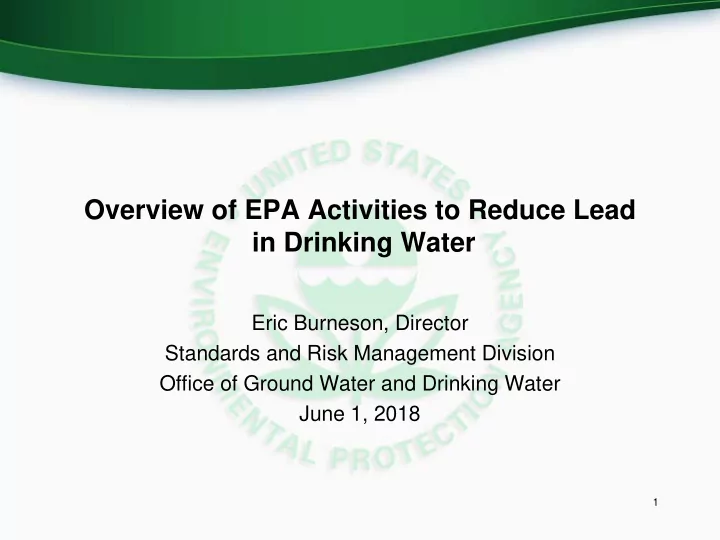

Overview of EPA Activities to Reduce Lead in Drinking Water Eric Burneson, Director Standards and Risk Management Division Office of Ground Water and Drinking Water June 1, 2018 1
Safe Drinking Water Act: Lead and Copper Rule (LCR) • The LCR addresses corrosion of lead and copper into drinking water primarily from service lines and premise plumbing. – Samples collected at the tap & 90 th percentile compared to action level – Optimized Corrosion Control Treatment – Public Education – Lead Service Line Replacement 2
LCR Implementation • Implementation of the LCR over the past twenty-five years has resulted in Time Period ALEs Systems with ALEs improvements in public 2005-2007 7,136 5,152 health. 2008-2010 5,247 3,924 • The number of large 2011-2013 4,323 3,349 drinking water systems exceeding the LCR action 2014-2016 3,147 2,440 level has decreased by over 90 percent since the initial implementation of the LCR. • EPA continues to see steady decrease in ALEs 3 among all systems
Key Challenges with the LCR • The LCR is one of the most complicated drinking water regulations for states and drinking water utilities to implement • The LCR is the only drinking water regulation that requires sampling in homes, often by the consumers themselves. • The rule includes complex sampling and treatment technique requirements to effectively limit corrosion of lead and copper from distribution systems and premise plumbing. • The current structure of the rule compels additional protective actions by water systems only after a potential problem has been identified (i.e., lead action level exceedance) • In many communities, lead service lines (LSLs), a primary source of lead are either are partially or entirely privately owned. 4
Addressing the Key Challenges • EPA provides ongoing support to water professionals and public officials through in-person and on-line trainings. • These trainings focus on the rule’s key challenges and help states and water systems: – Gain a better technical understanding of the rule. – Learn how to implement the rule requirements more effectively. • In 2017, EPA conducted a total of 27 in-person and online trainings on lead. The trainings: – Reached over 4,600 participants. – Included participants from all 50 states, tribes, stakeholders, schools and utilities. – Covered general rule requirements, optimal corrosion control treatment and required actions after systems exceed an action level – Provided information on non-regulatory efforts to reduce lead in drinking water in schools 5
LCR Revisions Outreach • EPA has engaged extensively with stakeholders/experts – Science Advisory Board – National Drinking Water Advisory Council – Small Business Regulatory Enforcement Fairness Act/SBAR Panel – Local Government Advisory Committee – Federalism Consultation with State and Local Partners – National Tribal Consultation 6
SAB Report on LCR Lead Service Line Replacement • Partial LSL replacement has not been shown to reliably reduce drinking water lead levels in the short term, ranging from days to months, and potentially even longer • Partial LSL replacement is associated with elevated drinking water lead levels for some period of time after replacement, suggesting the potential for harm, rather than benefit • Available data suggest that elevated tap water lead levels tend to stabilize over time following partial LSL replacement, sometimes at levels below and sometimes at levels similar to those observed prior to partial LSL replacement 7
LCR: Lead Exposure Modeling • As a part of EPA’s ongoing effort to understand and assess lead exposure to children, the agency conducted an expert peer review of draft scientific modeling approaches in June 2017. • Peer reviewers evaluated three approaches, all employing the Integrated Exposure Uptake Biokinetic (IEUBK) Model for Lead in Children, that model lead in drinking water’s effect on blood lead levels (BLLs) using a range of exposure scenarios. • Input from the peer review will help ensure that EPA is evaluating the best information and latest science on how lead in drinking water can potentially impact the health of children, one of our most vulnerable populations. • EPA is committed to use the best available science to inform LCR revisions to improve public health protection. For additional information on the peer review: https://www.epa.gov/dwstandardsregulations/lead- modeling-peer-review 8
Safe Drinking Water Act – Lead Free Plumbing • Section 1417 limits the amount of lead allowed in pipes, fittings, fixtures, solder and flux. • Defines “lead free” - not more than 0.25% lead for wetted surfaces for pipes, pipe fittings, plumbing fittings, and fixtures and not more than 0.2% lead for solder and flux • Prohibits pipe, fitting or fixture that is not lead free in the installation or repair of public water systems or plumbing providing water for human consumption • Exempts – (1) those “used exclusively for non-potable services” and (2) specifically named products (toilets, shower valves, fire hydrants, and 7 others) 9
Proposed Regulation: Lead Free Plumbing • Proposed Revisions January 2017 • Revise definition of “lead free” consistent with the 2011 Reduction of Lead in Drinking Water Act • Propose labeling and certification requirements for manufacturers. • Over 25,000 commenters received • Labeling • Certification • Exemptions 10
Recommend
More recommend